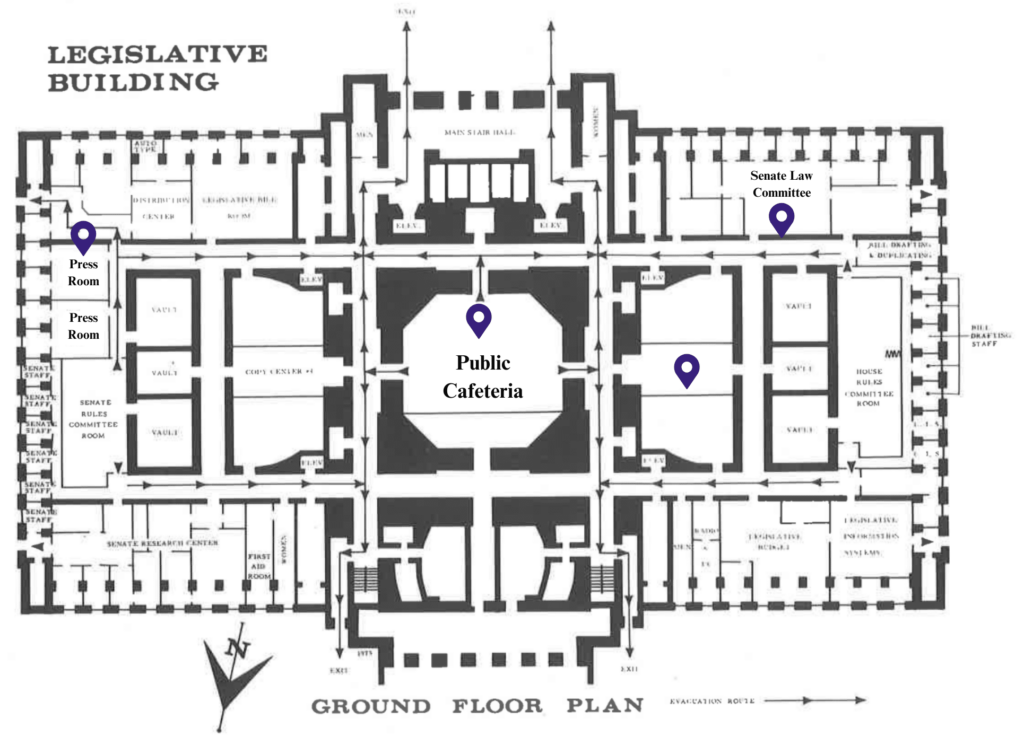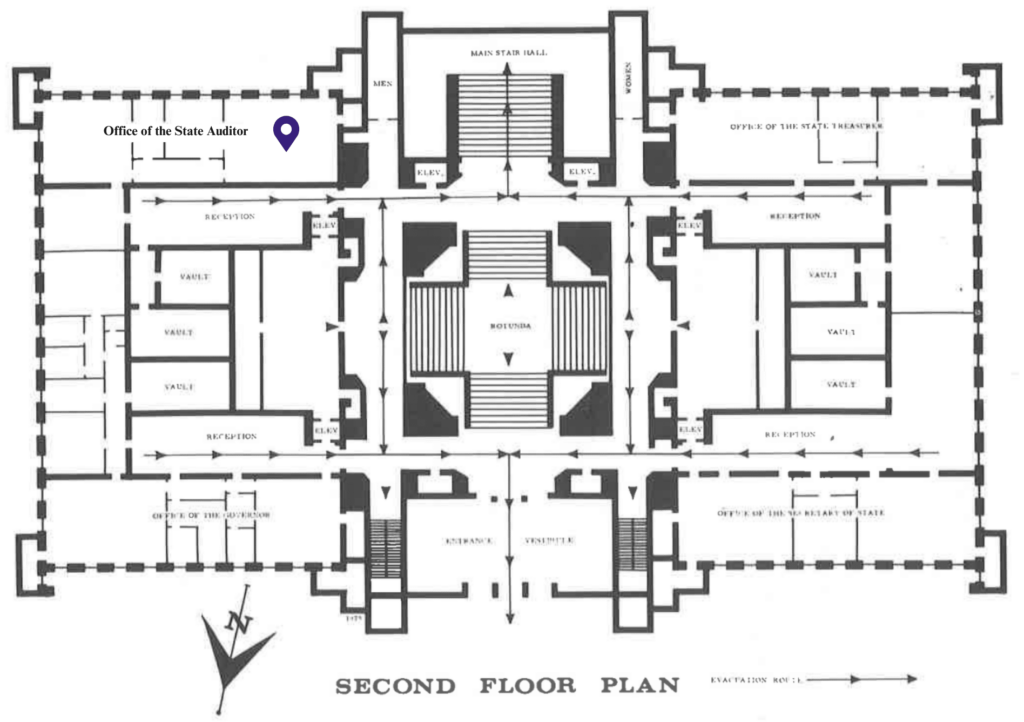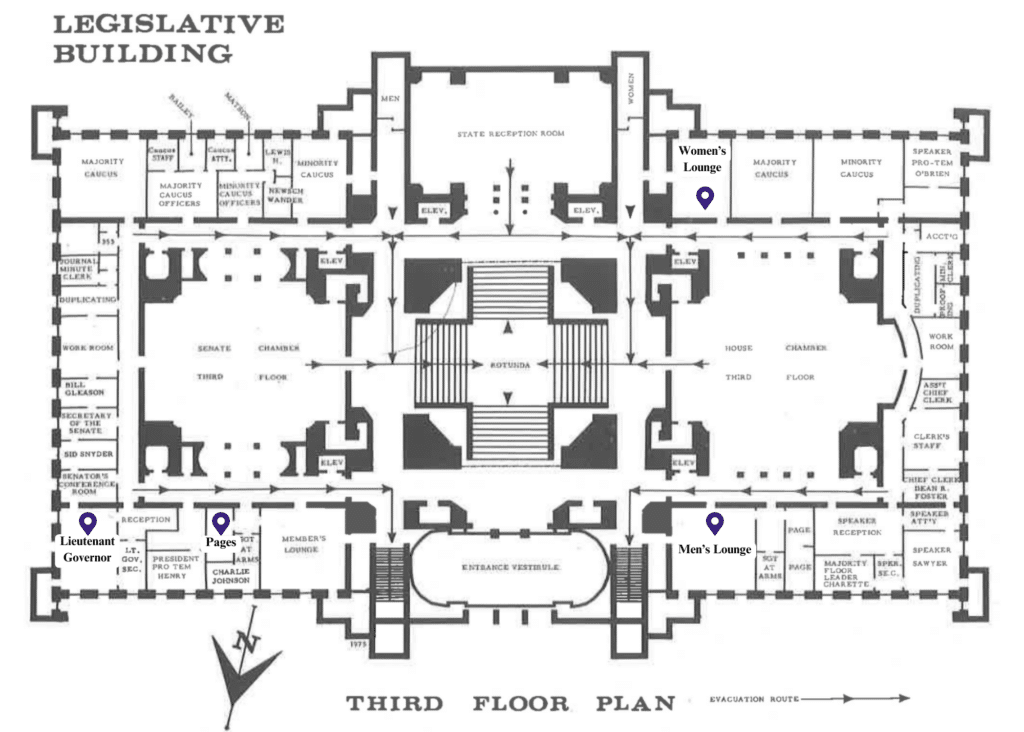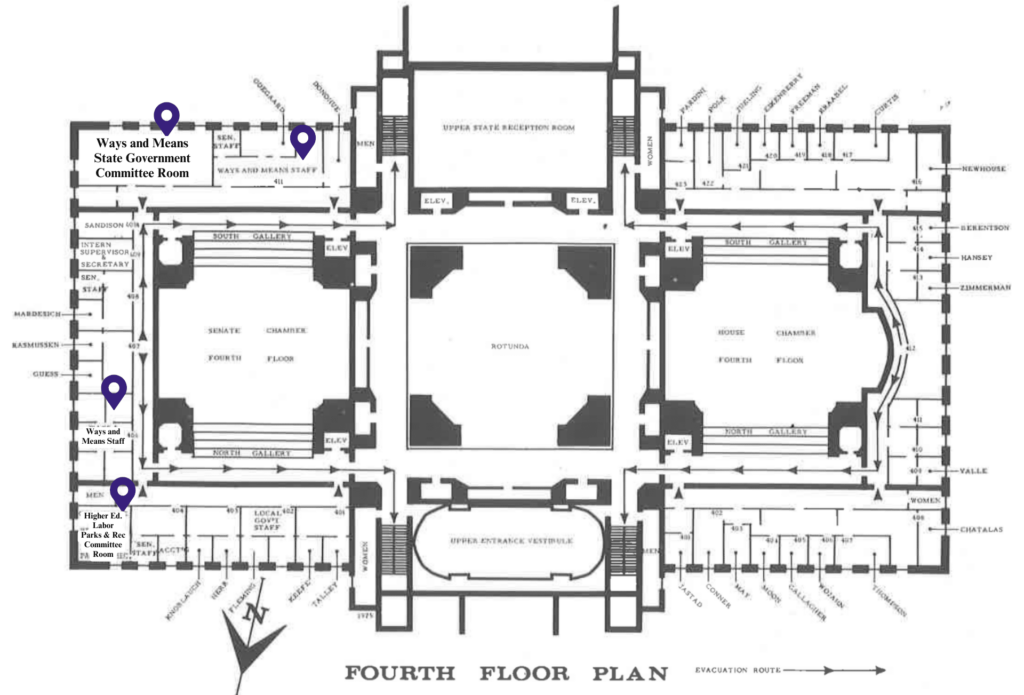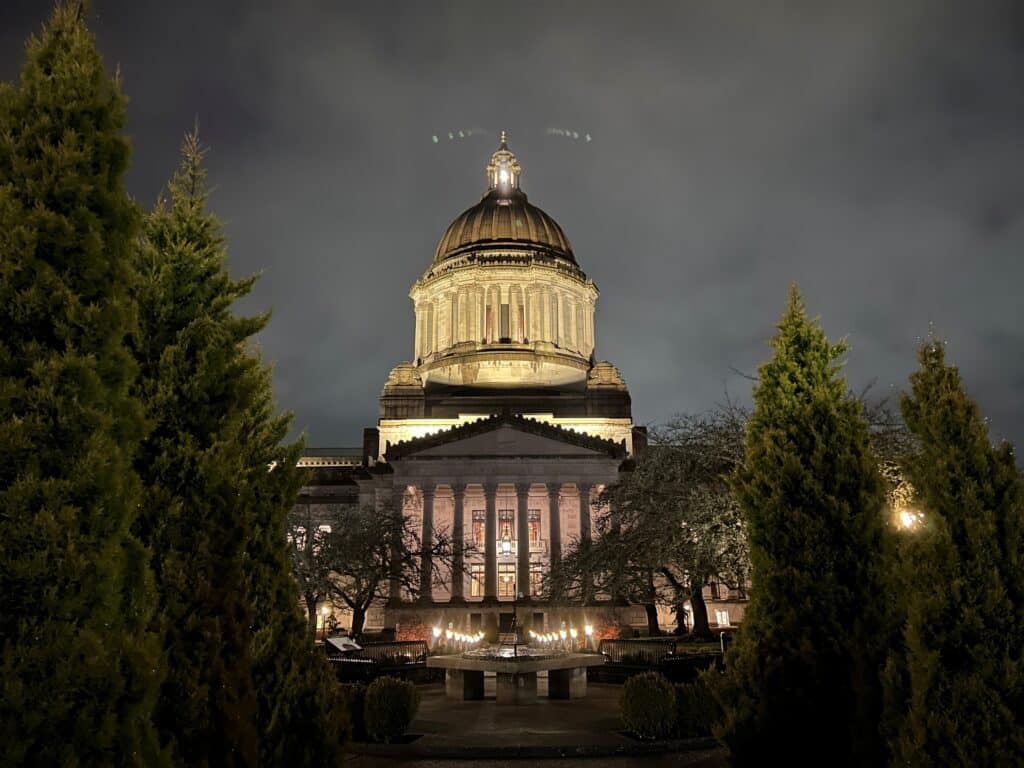
One-Third of the Way Through…
(Photo Courtesy: Erica Hallock)
Trivia!
Legislative committee hearings were held in the Legislative Building until which biennium?
Highlights of the Week
Potato Day!

Potato Day!
(Photo Courtesy: Erica Hallock)
Thanks to the Washington State Potato Commission, folks on the campus enjoyed potatoes with all of the fixings on Tuesday of this week. In one word – YUM!
Senate Majority Leader Jamie Pedersen opened the Legislative Democratic Media Availability this week saying everyone was excited for the best day on the calendar and I thought he was going to cite potato day. But, alas, he was talking about the upcoming policy committee cutoff. I was not alone with that thinking because Speaker Laurie Jinkins joked she thought he was referencing the beloved spuds.
Updated Caseload Forecast Numbers Released
On February 14, the Washington State Caseload Forecast Council released updated forecasts for entitlement caseloads ranging from Working Connections Child Care to K-12 enrollment to adult corrections to Medicaid. These updated forecasts reflect changes from the November 2024 forecast and, along with the March 18 Revenue Forecast, will be used to inform the 2025-27 biennial budget. Bottom line up front – the updated caseload forecasts did not show any sweeping changes from the November forecast.
It is important to remember that the caseload forecasts are based on current law and do not take into account potential shifts in caseloads based on pending statutory changes. For example, SHB 1489 (Ormsby) would delay some of the elements of the 2021 Fair Start for Kids Act, including income eligibility expansion and ECEAP entitlement. Because SHB 1489 is not yet law, the caseload forecasts assume the expansion and entitlement as reflected in the Fair Start for Kids Act are still occurring. Should SHB 1489 be enacted, the next caseload forecast would presumably reflect lower caseloads to reflect the statute changes.
Caseload Forecast by Early Learning Program Area: Comparing February 2025 Forecast to November 2024
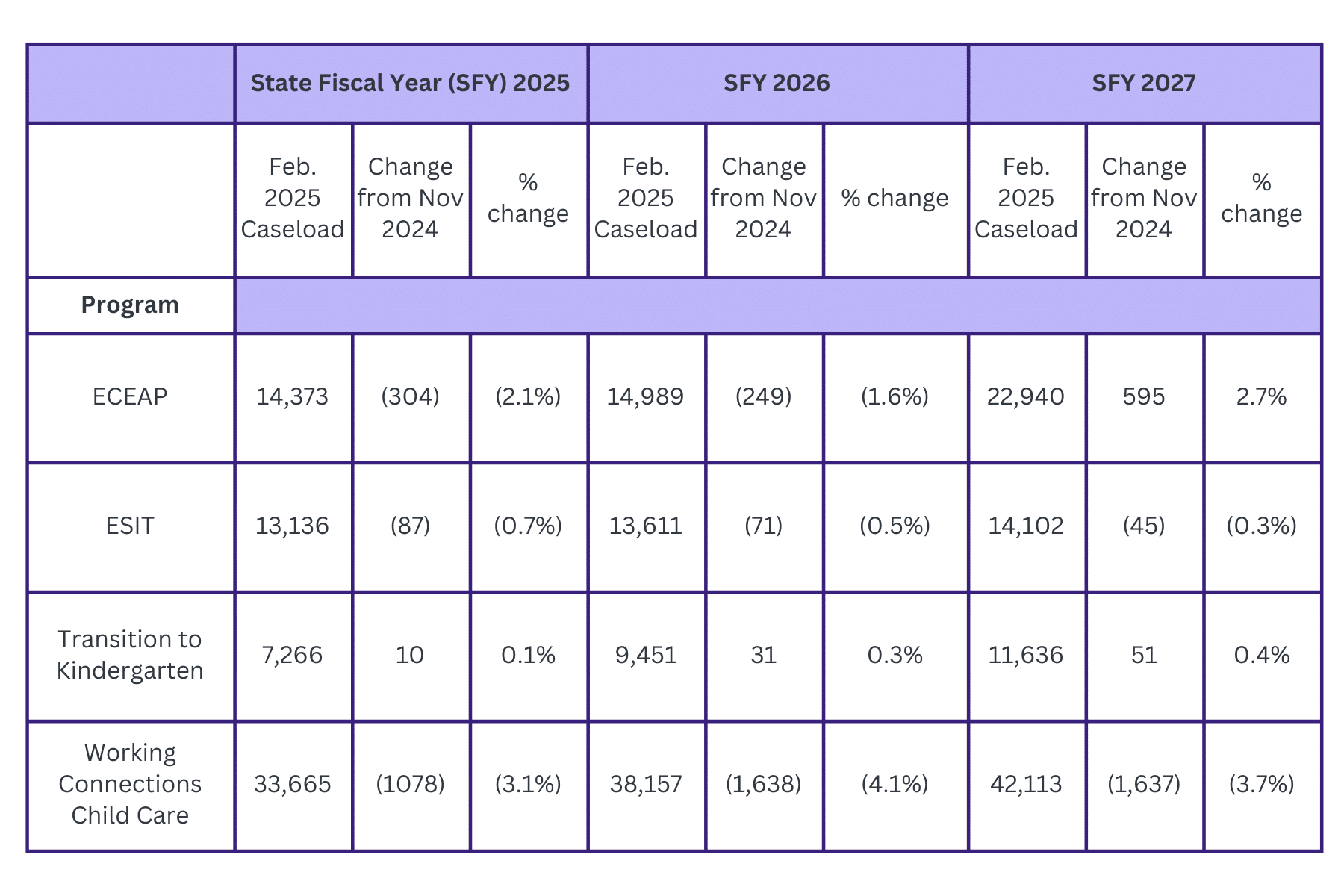
Following take-aways are from the program narratives:
- ECEAP. Actual enrollment is tracking 471 cases, or 3.5%, above the November forecast. Growth in non-entitled enrollment (the program’s largest area of growth in recent years) has slowed since October.
- Transition to Kindergarten. The forecast shows a negligible change from the November forecast. The assumption continues that 135 new classrooms will open each year.
- Working Connections Child Care. Actuals are tracking below the November forecast and the typical summer drop-off was larger than predicted. This is all contributing to the reduced caseload predictions.
Policy Committee Cutoff February 21 – Key Bill Action
As a reminder, each Thursday, Start Early Washington updates its bill tracker with the latest information on bills we are following. As noted last week, we are at the stage in the legislative process where changes can happen quickly so it’s always a good idea to check the legislative website for the latest information.
Executive Action Taken on Provider Qualifications Bill in Policy Committee
On February 17, the House Early Learning and Human Services Committee took executive action on SHB 1648 (Dent) relating to early learning provider qualifications.
The substitute bill adopted in executive session included the following changes:
- Allows licensed early learning providers until at least August 1, 2032 (or five years from the date of hire), whichever is later, to comply with qualification requirements. (The original bill included an extension date of August 1, 2035 or 10 years after date of hire and current law has a deadline of August 1, 2026 or five years after date of hire.)
- Establishes that a provider has demonstrated experience-based competency after working in a licensed child care setting without a break in service for at least five years. (Current rules require seven cumulative years to meet the standard by August 1, 2026. The substitute includes language requiring DCYF to adopt policies to allow for temporary breaks for parental leave, personal or family illness, etc.)
- Requires DCYF to convene a stakeholder group to identify strategies to implement early learning and school-age staff qualification requirements and verification processes and report to the Legislature with recommendations and implementation plans by December 1, 2026.
- Removes the provision in the original bill that would have reset the community-based training pathway to be made available in an online format and instead requires DCYF and the convened stakeholder group to identify options for offering the community-based training pathway in an online format.
Senate Early Learning Facilities Bill Receives Vote in Senate Fiscal Committee
By the time this newsletter hits your inbox, the Senate Ways and Means Committee should have taken executive action on SB 5297 (Trudeau) Thursday evening.
Like its companion, HB 1314 (Callan), SB 5297 would:
- Make Tribal Compact Schools eligible for the Early Learning Facilities (ELF) Public School District grant program.
- Subject to appropriations, establish an emergency grant program for projects that are necessary because of natural disaster or another health or safety threat resulting from unforeseen circumstances.
- Clarify that projects supporting the conversion of Early Childhood Education and Assistance Program (ECEAP) slots to full day and/or extended full day are eligible for ELF Fund grants.
- Remove the level of matching funds as a criterion for selecting projects and make other clarifying changes to matching requirements.
Effort to Revamp Transition to Kindergarten Passes House Education Committee
On February 18, the House Education Committee took executive action on SSB 1450 (Santos) to advance the Chair’s effort to revamp Transition to Kindergarten. The substitute bill adopted in committee struck the contents of the original bill and included the following key provisions:
- Provides that Transition to Kindergarten (TTK) is a policy applying to individual students, rather than a program.
- Defines eligibility as four-year-old children who need an additional year of preparation for kindergarten or live in extreme child care deserts and, despite qualifying, do not have access to ECEAP, Head Start or Working Connections Child Care.
- Beginning in the 2025-26 school year, limits the maximum number of TTK students to the number of students enrolled in the 2023-24 school year. (This would lead to approximately 2,000 less children served in TTK beginning in the 2025-26 school year than currently.)
- Directs that approved TTK sites must be distributed across the state, with areas prioritized that are classified as extreme child care deserts.
- OSPI must adopt an application process for schools interested in providing TTK. Application must include information about the number of sites for which approval is sought and projected number of children served; description of the screening process; statement with supporting documentation whether applicant is located in an extreme child care desert; results of the local child care and early learning needs assessment; and verification from Child Care Aware that the applicant worked in collaboration with and does not adversely impact enrollment in regional early learning programs.
- Requires OSPI to approve schools prior to enrolling students and prior to the school year.
- Requires OSPI to conduct site visits.
Homes for Heroes Bill Receives Public Hearing in House Capital Budget Committee
On February 20, the House Capital Budget Committee held a public hearing on HB 1022 (Connors). Named the “Creating a Home for Heroes Program,” the bill would create a down payment and closing assistance program for people who work in targeted professions and who meet certain income requirements.
Eligible employees include the owner or employee of a licensed or certified child care center, licensed or certified nature-based child care, or licensed family child care home.
Governor Ferguson called out this bill in his inaugural address and said he was excited to work with the bill’s prime sponsor Representative Connors to get the bill to his desk.
Because the House Capital Budget Committee is a fiscal committee, this bill is subject to the February 28 fiscal committee cutoff.
What’s on Deck for Next Week
Fiscal Committee and Other Upcoming Deadlines
Our next cutoff date is coming upon us quickly with the deadline for bills to advance out of Fiscal Committees by Friday, February 28.
Following the February 28 Fiscal Committee cutoff, the next key cutoff date is March 12 – the deadline for bills to be passed out of their House of Origin.
The following week, on March 18, the latest Revenue Forecast will be released. These updated revenue numbers will be used to inform final budget writing.
What Does “NTIB” Mean?
Like the English language, the legislative process has exceptions to its rules. Bills deemed Necessary to Implement the Budget (or NTIB) are exempt from the cutoff deadlines due to budgetary impacts. These bills still must go through each of the steps – they must, for example, receive a Floor vote (no skipping steps!). NTIB status is granted by legislative leadership and is not broadly given.
The reason I share this explanation now is it may appear that some bills are “dead” because they have not advanced through the various policy and fiscal committees by the requisite cutoffs, but they may not actually be dead because they may be deemed NTIB. In short, nothing is ever dead until the final gavel goes down on Sine Die!
Governor Ferguson Expected to Release Next Steps for State Agency Reduction Exercises
As reported in the February 7 “Notes from Olympia,” Governor Bob Ferguson directed state agencies to submit to the Office of Financial Management (OFM) potential budget reductions of at least six percent beyond those reductions included in former Governor Jay Inslee’s public “Book 2” budget.
A February 12 Washington State Standard article reported this exercise would yield approximately $1.8B in savings over the 2025-27 biennium. The article also shared the “cut targets” for state agencies. DCYF’s target was the third largest of the state agencies (note that the Office of Public Instruction was exempt from the exercise) with a two-year reduction goal of $300M. The agency with the largest target was the Department of Social and Health Services with a two-year target of $702.5M and the second largest was the Health Care Authority (the Medicaid administration agency) with $534M.
During a press availability last week focused on Governor Ferguson’s response to the Trump Administration’s actions impacting Washington state, Governor Ferguson addressed the status of this reduction exercise in response to a reporter’s question. Governor Ferguson replied he and his team are actively reviewing the state agency responses and he plans another press availability sometime during the window of February 25-27 to share his administration’s proposed next steps.
Week Seven Schedule
With the policy committee cutoff this week, nearly all the action in week seven will be in the fiscal committees beginning with scheduled Saturday meetings (on February 22) for both the House Appropriations and Senate Ways and Means committees. When next week’s committee schedule came out, it was filled with “bills referred to committee” which are essentially calendar holds. If you are tracking a specific bill carefully, your best bet is to follow the legislative webpage.
Sadly, I am unaware of any scheduled free food days.


